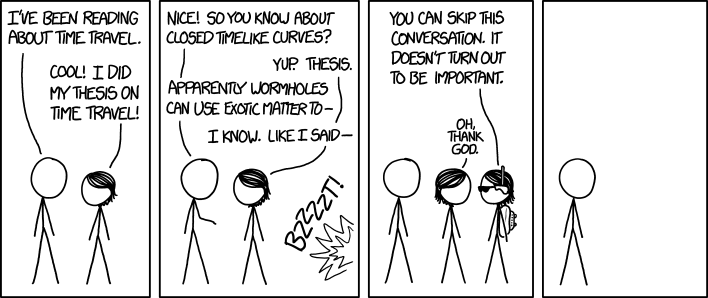1. A bunch of people emailed me to ask about the paper “Realization of a scalable Shor algorithm”: a joint effort by the groups of my MIT colleague Ike Chuang and of Innsbruck’s Rainer Blatt. The paper has been on the arXiv since July, but last week everyone suddenly noticed it because it appeared in Science. See also the articles in MIT News and IEEE Spectrum.
Briefly, the new work uses Kitaev’s version of Shor’s factoring algorithm, running on an ion-trap quantum computer with five calcium ions, to prove that, with at least 90% confidence, 15 equals 3×5. Now, one might object that the “15=3×5 theorem” has by now been demonstrated many times using quantum computing (indeed, Chuang himself was involved in the historic first such demonstration, with Neil Gershenfeld in 1997). Furthermore, if one counts demonstrations not based on quantum computing, some people have claimed even earlier precedents for that theorem.
Nevertheless, as far as I can tell, the new work is a genuine milestone in experimental QC, because it dispenses with most of the precompilation tricks that previous demonstrations of Shor’s algorithm used. “Precompilation tricks” are a fancier term for “cheating”: i.e., optimizing a quantum circuit in ways that would only make sense if you already assumed that 15 was, indeed, 3×5. So, what’s new is that a QC has now factored 15 “scalably”: that is, with much less cheating than before.
Of course, as I’m sure the authors would acknowledge, the word “scalable” in their title admits multiple interpretations, rather like the word “possible.” (It’s possible to buy strawberry Mentos, and it’s also possible to convert the Sun into computronium, but for different senses of “possible.”) As I wrote in the comments section of my last post:
There are still all the difficulties of integrating a huge number of qubits—which, in ion-trap implementations, would almost certainly mean having many traps that can communicate with each other using gate teleportation—as well as implementing quantum fault-tolerance (meaning: doing 2-qubit gates at the fault-tolerance threshold, moving qubits around to the right places, pumping in fresh qubits, pumping out dirty ones, etc). Those all remain major engineering problems for the future.
See also this comment by Vaughan Pratt, who remarks: “the MIT press release … would appear to have translated [‘scalable’] to mean that RSA was now approaching its best-by date, although the paper itself makes no such claim.”
In any case, regardless of how long it takes until we can factor enormous numbers like 91, congratulations to the MIT and Innsbruck groups on what’s certainly progress toward scalable ion-trap QC!
2. Other people wrote to ask about a striking recent preprint of Kaplan, Leurent, Leverrier, and Naya-Plasencia, which points out how Simon’s algorithm—i.e., the forerunner of Shor’s algorithm—can be used to break all sorts of practical private-key authentication schemes in quantum polynomial time, assuming the adversary can query the scheme being attacked on a coherent superposition of inputs. In practice, this assumption is unlikely to hold, unless the adversary gets the actual obfuscated code of the scheme being attacked (in which case it holds). Also, this is not the first time Simon’s algorithm has been used to attack cryptography; previous work in the same spirit by Kuwakado and Morii showed how to use Simon’s algorithm to break the 3-round Feistel scheme and the Even-Mansour scheme, again if we assume superposition queries.
Even so, Kaplan et al. seem to pretty dramatically expand the range of “practical” cryptosystems that are known to be vulnerable to Simon attacks in the superposed-query model. I suspect this will force a revision in how we talk about Simon’s algorithm: from “useless, but theoretically important, and historically important because it led to Shor’s algorithm” to “actually maybe not that useless.” (See here for a previous attempt of mine to give an interesting “explicit” problem that Simon’s algorithm solves in polynomial time, but that’s classically hard. Alas, my candidate problem turned out to be classically easy.) This is analogous to the revision that “Einstein-certified randomness” and the RUV theorem recently forced in how we talk about Bell’s inequality: we can no longer tell students that Bell’s work was important because of the conceptual point it proved about local hidden variables, and because of all the other stuff it led to, even though it obviously has no applications in and of itself. Now it does have applications in and of itself.
To a quantum complexity theorist like me, who doesn’t know nearly as much applied crypto as he should, the real news in the Kaplan et al. paper is not that Simon’s algorithm can break the sorts of systems they study. Rather, it’s that so many systems that are vulnerable to Simon attack exist and are used in the first place! Once people understand the problem, I doubt it will be hard to design schemes of similar efficiency that remain quantum-secure even in the superposed-query model (under some plausible assumption, like that an underlying one-way function is quantum-secure). Indeed, recent work of Boneh and Zhandry, among others, has already taken significant steps in that direction. So the situation doesn’t seem “as bad” as it was with public-key crypto, where once Shor’s algorithm comes along, the plausibly quantum-secure alternatives that we currently know (like lattice-based crypto and quantum key distribution) are either much less efficient than RSA and Diffie-Hellman, or else require new hardware. Still, the new observations about Simon’s algorithm show us how the history of quantum computing could have unfolded differently: rather than Simon → Shor → everyone gets excited (because their crypto is now vulnerable), people could’ve gotten cryptographically excited immediately after Simon.
3. Speaking of Diffie-Hellman, belated congratulations to Whitfield Diffie and Martin Hellman for an extremely well-deserved Turing Award!
4. At MIT’s weekly quantum information group meeting, Aram Harrow spoke about his new paper with Ed Farhi, “Quantum Supremacy through the Quantum Approximate Optimization Algorithm.” Using the same arguments developed around 2010 by me and Alex Arkhipov, and (independently) by Bremner, Jozsa, and Shepherd, this paper shows that, even though the recently-developed QAOA/Quinoa quantum optimization algorithm turns out not to beat the best classical algorithms on the Max E3LIN2 problem (see here and here)—still, whatever that algorithm does do, at least there’s no polynomial-time classical algorithm that samples from the same distribution over outputs, unless the polynomial hierarchy collapses.
In other words: even if the algorithm fails at its original goal, it’s still hard for a classical computer to reproduce its exact pattern of failure! Hence: Quantum Supremacy.
A secondary goal of Aram and Eddie’s paper is to make the Aaronson-Arkhipov and Bremner et al. arguments more accessible to physicists, by decreasing the amount of “weird complexity theory” invoked. (I suppose I’ve asked for this—for physicists to de-complexify complexity theory—by telling everyone for years how easy quantum mechanics becomes once you take away the physics!) I’ll leave it to physicists to judge how well Aram and Eddie succeed at their pedagogical goal, but I’m thrilled by any such effort to communicate across fields. Aram’s talk would surely have served that same educational purpose, had it not gotten derailed partway through by Donald Trump jokes from the audience. (My contribution: “Aram, will you disavow support from quantum supremacists?”)
Unrelated Update: Some people might be interested in this brief interview with Michael Cerullo, who read The Ghost in the Quantum Turing Machine and wanted to ask me about “the relevance of quantum mechanics to brain preservation, uploading, and identity.”






